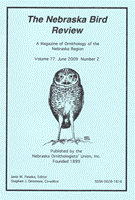Nebraska Ornithologists' Union
Date of this Version
12-2013
Document Type
Article
Citation
Silcock, “Fall Field Report, August–November 2013,” from Nebraska Bird Review (December 2013) 81(4).
Abstract
In most ways, this was a routine fall season. Most interesting from an ongoing point of view were quite a large number of sightings of passerines at rather late dates, notably Empidonax flycatchers, wood warblers, native sparrows, tanagers, towhees, grosbeaks, and buntings. A similar phenomenon was noted among a few cold-sensitive non-passerines, such as Black and Common Terns.
One of the more significant ongoing trends is the proliferation of western and southern hummingbirds and the alteration of traditional migration and summer ranges; no fewer than 6 species were found. Calliope and Rufous Hummingbirds were seemingly more numerous in the east than the west, while a pair of Ruby-throateds summered in a Scotts Bluff County yard. Nebraska's second Costa's was seen by many, and its third Black-chinned was well documented. Strangely, there was only one report of Broad-tailed Hummingbird.
Other range perturbations of note were a mixed bag of the worrisome and the encouraging, including an extension of breeding sites of Mississippi Kite in North Platte, reduced numbers of both cuckoos (only one Black-billed was reported), the apparent serious and continuing decline of Black-billed Magpie as ably characterized by Wayne Mollhoff, the uptick in numbers of Rusty Blackbird in the state, the essential absence of Purple Finch and Pine Siskin during the fall, and the good numbers reported of Lesser Goldfinch.
Good numbers were reported for an eclectic group of species: Pacific Loon, Common Nighthawk, Chimney Swift, Purple Martin, and Green-tailed Towhee, while an interesting group of rarities showed up (in addition to Costa's and Black-chinned Hummingbirds): Parasitic and Long-tailed Jaegers, a possible Cave Swallow, and a possible first Nebraska record of a western subspecies of Hermit Thrush. Perhaps the saddest item was the apparent demise of an abandoned juvenile Whooping Crane west of Alliance, likely the work of coyotes.



Comments
Copyright 2013 Nebraska Ornithologists' Union. Used by permission.